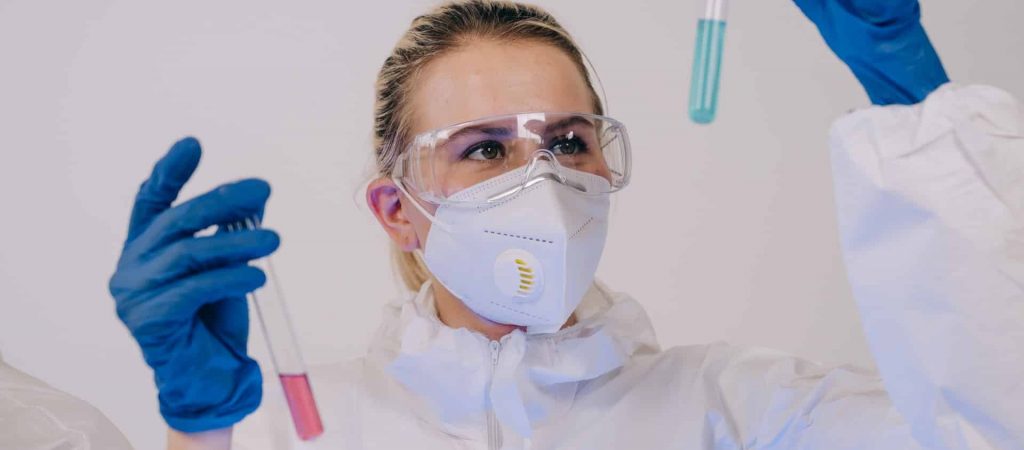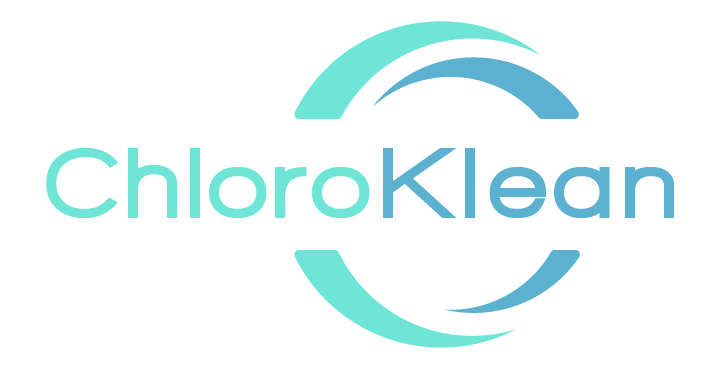
ClO₂ structure and its reactions
Because of its radical structure, Chlorine Dioxide has a particular reactivity – totally different from that of chlorine or ozone.
The electrophilic nature of chlorine or hypochlorous acid can lead, through reaction of addition or substitution, to the formation of organic species while the radical reactivity of chlorine dioxide mainly results in oxycarbonyls.

Generally Chlorine Dioxide (ClO2) rapidly oxidises phenol type compounds, secondary and tertiary amines, organic sulphides and certain hydrocarbon polycyclic aromatics such as benzopyrene, anthracene and benzoathracene.
In general, Chlorine Dioxide will not react on double carbon bonds, aromatic cores, quinionic and carboxylic structures as well as primary amines and urea.
Commercial applications have shown that Chlorine Dioxide can effectively oxidise many compounds considered to be waste and water pollutants. The table below lists a selection of pollutants found in various industries from our files, and demonstrates the wide range of possible applications for Chlorine Dioxide. ChloroKlean possess over 25 years application expertise in chlorine dioxide technology in challenging applications.
Aldehydes
In general, Chlorine Dioxide can oxidise an aldehyde to its corresponding carboxylic acid. Aldehydes are produced by a number of common industrial processes. Their treatment is a common problem, especially so in the photographic industry. Formaldehyde is a major component in the formulations used in photo processing. Chlorine Dioxide oxidises formaldehyde to formic acid and finally to carbon dioxide. Para formaldehyde can be depolymerised and eliminated completely by oxidation with Chlorine Dioxide.
Amines and Mercaptans
The major sources of odorous substances such as mercaptans and substituted amines include the chemical and petroleum industries, cooking and sanitary processes, animal feedlots and rendering plants.
Between pH 5 & 9, 4.5 parts by weight of Chlorine Dioxide instantaneously oxidises 1 part by weight of mercaptan (expressed as sulphur) to the respective sulphonic acid or sulphonate compound, thus destroying the mercaptan odour. Similarly, chlorine dioxide reacts with organic sulphides and disulphides destroying the original odour.
Secondary and tertiary amines are also present in many waste water’s, causing their own unique odour problems. The oxidation of amines with Chlorine Dioxide depends on the pH of the reaction mixture and the degree of substitution of the amine.
Between pH 5 and 9, an average of 10 parts by weight of Chlorine Dioxide oxidises 1 part by weight of a secondary aliphatic amine (expressed as nitrogen) removing all traces of amine odour. The higher the pH of the reaction mixture (chlorine dioxide and tertiary and/or secondary aliphatic amines) the more rapidly oxidation proceeds.
THM Precursors
The key to understanding why Chlorine Dioxide is so effective can be found in the differences in the reactions of chlorine dioxide and chlorine with Tri-halomethane (THM) precursors such as humic and fulvic acids.
Chlorine reacts with THM precursors by oxidation and electrophilic substitution to yield both volatile and non-volatile chlorinated organic substances (THMs).
Chlorine Dioxide, however reacts with THM precursors primarily by oxidation to make them non-reactive or unavailable for THM production. This means that pre-treatment with chlorine dioxide has an inhibiting effect on THM formation when chlorine is subsequently used.
Pesticides
Chlorine Dioxide can oxidise toxic materials to less toxic materials. Specifically, Methylchlor (DMDT) and Adrian react with ClO2. With parathion, the reaction is slow near to pH 7; however, when pH is above 8, less biodegradable herbicides such as paraquat and diquat are eliminated within a few minutes.
Algae/Slime
Chlorine Dioxide has been sown to be effective in controlling algae growth. In one study, ClO2 was found to be more effective than copper sulphate, at comparable treatment costs. Chlorine Dioxide is believed to attach the pyrolle ring of the chlorophyll. This leaves the ring and leaves the chlorophyll inactive. Since algae cannot function without chlorophyll metabolism, they are destroyed. The reaction of Chlorine Dioxide with algae and their essential oils forms tasteless, odourless substances.
Algae control is carried out by adding chlorine dioxide to the reservoir at night (To prevent photolytic decomposition of ClO2) The algae killing action is fast enough to be effective before the sun rises. A dosage of 1 mg/litre has been reported to control algae populations
Sulphides
Between pH 5 and 9, an average of 5.2 parts by weight of Chlorine Dioxide instantaneously oxidises 1 part by weight of hydrogen sulphide (expressed as sulphide ion) to the sulphate ion.
Many industrial processes produce sulphide-containing gases and waste products. These are generated, for example, during petroleum refining, coal coking, black liquor evaporation in kraft pulping, viscose rayon manufacture and natural gas purification. These gases and wastes are frequently scrubbed with alkaline solutions and require treatment before discharge.
Nitrogen Compounds
Nitrogen oxides are dangerous and corrosive. Nitrous Oxide (NO) and nitrogen dioxide (NO2) are industrial effluents which result from fuel combustion, nitric acid manufacture and use, and from metal finishing operations which use nitrates, nitrites or nitric acid. Other sources include chemical processes in which nitrogen compounds are used as reagents.
Chlorine Dioxide has been used to scrub these contaminants. Nitric Oxide contained in gas discharges from coke kilns may be eliminated by oxidation by Chlorine Dioxide. This process is particularly convenient for continuous operation.
Cyanides
Cyanide compounds originate from processes such as metal plating, steel case hardening, pickle liquor neutralising, gold and silver ore refining and blast furnace stack gas scrubbing. Chlorine Dioxide oxidises simple cyanide to cyanate (a less toxic substance) and/or carbon dioxide and nitrogen. The end products depend on reaction conditions.
In neutral and alkaline solutions below pH 10, an average of 2.5 parts by weight of chlorine dioxide oxidises 1 part by weight of cyanide ion to cyanate. Above pH 10, an average of 5.5 parts by weight of Chlorine Dioxide oxidises 1 part by weight of cyanide ion to carbon dioxide and nitrogen. Chlorine Dioxide does not react with cyanate ion, nor has it been observed to form cyanogen chloride during the oxidation of cyanide.
Chlorine Dioxide also oxidises thiocyanate to sulphate and cyanate. In neutral solutions, an average of 3.5 parts by weight of chlorine dioxide oxidises 1 part by weight of thiocyanate ion.
For more interesting facts on Chlorine Dioxide see these pages:
What is Chlorine Dioxide?
Advantages of ClO2 Over Chlorine
Advantages Over Other Oxidising Biocides
ChloroKlean is the first choice for businesses considering Chlorine Dioxide. We specialise in delivering Chlorine Dioxide (ClO2) dosing systems using the latest technology and expertise.

At ChloroKlean we are always keen to be of assistance to our clients from all over the world while offering remarkable products with a time-tested customer service. Tell us what your requirements are and we will gladly help you proceed.








